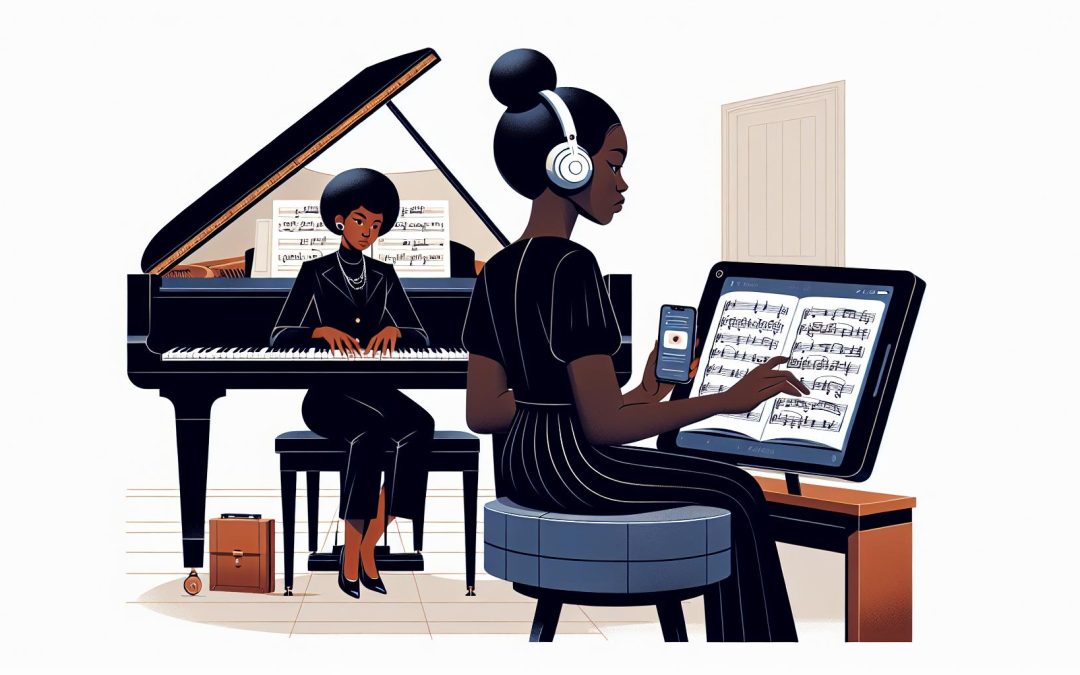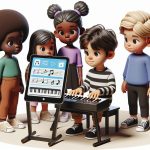Learning to play the keyboard by ear is like unlocking a superpower. It's about letting the music flow through you, catching every nuance and emotion without being tethered to sheet music. Imagine sitting down at your keyboard and effortlessly playing any song that comes to mind, just by listening to it. Sounds magical, doesn't it?
This journey isn't just for the "musically gifted"; it's a skill that anyone with a passion for music can develop. With patience, practice, and a few insider tips, they'll soon be translating the music they hear into beautiful keyboard melodies. Let's dive into the world of playing the keyboard by ear, where they'll learn to trust their instincts and let their creativity soar.
Understanding the Basics of Music Theory
Before diving headfirst into playing the keyboard by ear, it's crucial to grasp some fundamental concepts of music theory. These are the building blocks that will enable anyone to more accurately understand and replicate the music they hear. It’s like learning the alphabet before writing a story.
Firstly, knowledge of scales is essential. Scales form the foundation of music, with the Major and Minor scales being the most common. Understanding scales helps in identifying the mood of a piece - whether it’s cheerful or melancholic. For someone aiming to play by ear, recognizing these scales in songs can significantly simplify the learning process.
Then, there are chords, which are groups of notes played together to add harmony. Familiarizing oneself with basic chords and their variations opens up a vast array of songs to play. The beauty of chords lies in their versatility; learning just a few can enable a musician to play numerous songs.
Rhythm and timing come next. They’re the heartbeat of any piece of music. Grasping different beats and time signatures is key to understanding the pace and flow of a song. Without rhythm, even the right notes can sound off if not played in time.
Lastly, ear training exercises are indispensable. They sharpen one’s ability to distinguish between different notes, chords, and scales. Simple practices like trying to identify the notes of everyday sounds or humming a song and then finding those notes on the keyboard can be incredibly beneficial.
Here’s a quick overview of these basic music theory elements:
| Element | Description |
|---|---|
| Scales | Foundation of music, defining its mood |
| Chords | Groups of notes adding harmony |
| Rhythm and Timing | The heartbeat of music, essential for flow |
| Ear Training | Exercises to identify notes by ear |
These elements of music theory, while might seem daunting at first, are actually quite accessible. Websites, apps, and online tutorials offer endless resources for those eager to learn. Starting with these basics, anyone can begin to understand the language of music. This understanding not only enhances one’s ability to play by ear but also deepens the overall musical experience.
Developing Your Ear for Music

Training one's ear is a fundamental aspect of learning to play the keyboard by ear. This process involves sharpening the ability to recognize and differentiate between various pitches, tones, and chords. Active listening plays a crucial role in this phase. It entails more than just hearing music; it's about analyzing and understanding the components that make up a piece. By frequently listening to a wide range of music, individuals can start to identify patterns, rhythms, and harmonies, which are instrumental in developing a keen ear for music.
Practical exercises are another essential method for honing listening skills. These exercises might include:
- Singing scales and arpeggios: Vocalizing helps to internalize the sound of different notes and how they relate to each other.
- Repeating melodies and harmonies: Listening to short segments of music and then trying to play or hum them back helps in memorizing and recognizing musical elements.
- Using music theory apps: Many apps are designed to train the ear by presenting interactive challenges such as identifying intervals, chords, and scales.
These activities not only enhance one's ability to discern musical components by ear but also aid in translating those auditory cues into physical actions on the keyboard.
Feedback is indispensable in this learning phase. Recording one's playing sessions and comparing them with the original pieces provides insight into areas that require improvement. It's also beneficial to play in front of others or a teacher who can offer constructive criticism and guidance.
Embracing The Learning Curve
Understandably, developing an ear for music doesn’t happen overnight. It’s a skill that unfolds and improves over time, often through trial and error. Patience is key. Beginners might find it challenging at first to pick out individual notes or to follow chord progressions by ear. However, with consistent practice, these tasks become more manageable, and eventually, intuitive. Celebrating small victories, such as successfully playing back a melody heard only a few times, can be incredibly motivating.
The Role of Music Theory
While the focus is on playing by ear, a basic understanding of music theory cannot be understated. Knowing the building blocks of music—such as scales, chords, and intervals—provides a language through which one can understand and communicate musical ideas more effectively. When an individual hears a piece of music, being able to theoretically dissect it enables a smoother translation of what's heard into playing it on the keyboard.
Ear Training Exercises for Keyboard Players

Ear training is a crucial part of learning to play the keyboard by ear. It involves developing the ability to identify pitches, intervals, chord progressions, and rhythms just by listening. Here are some effective exercises that can help keyboard players sharpen their listening skills and improve their musical ear.
Identify Single Notes
Start by playing a single note on the keyboard without looking at the keys. Try to identify the note either by its name (C, D, E, etc.) or its position (do, re, mi in solfège). Initially, it might seem challenging, but with consistent practice, the ability to recognize notes quickly improves. An interesting way to practice is by using flashcards with note names and trying to play them on the keyboard without peeking.
Interval Recognition
Intervals, the distance between two pitches, are the building blocks of music. Recognizing intervals by ear is pivotal for understanding and identifying melodies. To practice this:
- Play two notes simultaneously or sequentially and attempt to identify the interval.
- Start with larger, easier-to-distinguish intervals like octaves and fifths, gradually moving to smaller, more challenging ones.
- Utilizing an intervals chart or app can provide a structured way to approach this exercise.
Chord Progressions
Understanding and identifying chord progressions by ear is essential for playing music more expressively and improvisationally on the keyboard. To enhance this skill:
- Play simple chord progressions in a loop and try to identify each chord.
- Focus on common progressions at first, such as the I-IV-V (one-four-five) progression.
- Experiment with different keys to familiarize your ear with the same progression in various tonal contexts.
Rhythmic Dictation
Rhythmic patterns form the backbone of any piece of music. Being able to discern and replicate rhythms by ear is crucial. Practice tips include:
- Listen to a rhythm and try to tap it back or replicate it on the keyboard.
- Start with simple rhythms, increasing complexity as you improve.
- Use a metronome to help keep time and improve your rhythmic precision.
- Listening to a piece of music and trying to pick out individual parts, such as the melody, bass line, or specific instruments.
- Attempting to replicate what you hear on the keyboard.
- Analyzing songs to
Translating Songs into Keyboard Melodies

After developing a strong foundation in ear training, the next exciting step for keyboard learners is Translating Songs into Keyboard Melodies. This process involves listening to melodies and then replicating them on the keyboard, offering a practical application of ear training skills. It's not only fun but also greatly enriches a musician's ability to play by ear and understand music more deeply.
The first step in this journey is to start with simple melodies. Nursery rhymes, folk songs, or even the melody line of popular songs are great places to begin. These melodies usually have straightforward structures making them easier to identify and play by ear. The learner should listen to the melody several times, hum or sing along, and then attempt to find the notes on the keyboard. This method encourages active listening and reinforces the connection between what they hear and what they play.
To aid in this process, keyboard learners should break down the song into smaller, manageable segments. Tackling a melody one phrase at a time ensures that the learner doesn't get overwhelmed and allows for focused, detailed listening. Once they’ve mastered a segment, they can proceed to the next, gradually piecing the song together.
Another effective strategy is using technology to slow down the music. Apps and software that can adjust the tempo of a song without altering the pitch are invaluable tools. Slowing down the music gives learners more time to discern notes, rhythms, and intervals, making the learning process smoother and more accessible.
Listening for the baseline of a song provides another clue for translating melodies. The bass line often outlines the chord progressions and can guide the learner in understanding the song’s structure. By playing the bass notes with the left hand while the right hand plays the melody, learners begin to achieve a fuller sound and a deeper understanding of the song's composition.
Practicing this translation from hearing to playing requires patience and persistence. It's common to encounter mistakes or to not find the right notes immediately. However, every attempt sharpens the ear and enhances the ability to decode melodies. Feedback is critical during this stage; recording one’s playing and comparing it to the original track can reveal discrepancies and areas for improvement.
Tips to Enhance Your Learning Journey

When it comes to mastering the keyboard by ear, practice is key, but there are strategies that can make your journey smoother and more enjoyable. Here are several tips that can help enhance your learning experience.
Immerse Yourself in Music
One fundamental tip is to immerse yourself in music as much as possible. This doesn't just mean practicing on the keyboard; it also involves listening actively to a wide variety of music. Try to expose yourself to different genres, styles, and periods. Listening to a broad spectrum of music will help you identify and understand patterns, rhythms, and harmonies more intuitively.
Use Technology to Your Advantage
In today's digital age, an array of apps and software is available to aid in ear training and music learning. Applications that slow down music without altering the pitch can be incredibly helpful for beginners trying to pick out notes and chords in fast melodies. Furthermore, there are online platforms that offer interactive ear training exercises tailored to various skill levels.
Set Realistic Goals
It's crucial to set realistic and achievable goals for yourself. Whether it's mastering a specific song by ear within a month or being able to identify all major chords and intervals, having clear, attainable targets will keep you motivated. Make sure to celebrate every small victory along the way; this reinforces your progress and encourages you to keep pushing forward.
Create a Practice Schedule
Consistency is vital when learning any new skill. Creating a structured practice schedule that you can stick to is essential. Even 15 to 30 minutes of focused practice every day is more beneficial than occasional, longer sessions. Tailor your practice times to when you're most alert and productive to make the most out of each session.
Record and Evaluate Your Progress
Recording your practice sessions can provide invaluable feedback. Listening back to yourself playing can highlight areas that need improvement and help you track your progress over time. It's also beneficial to occasionally play alongside the original tracks to gauge how closely you're able to replicate the melodies and harmonies by ear.
Engage with a Community
Learning in isolation can be challenging, so it's advisable to engage with a community of learners. Whether it's through online forums, social media groups, or local music clubs, connecting with others on the same journey can offer support, motivation, and advice. Sharing experiences and tips with fellow learners can greatly enhance your learning experience.
Conclusion
Mastering the keyboard by ear is a journey filled with its own set of challenges and rewards. By immersing yourself in music and leveraging technology, you're setting the stage for a fulfilling learning experience. Remember, the key to success lies in consistent practice and engaging with a supportive community. So, keep setting those realistic goals, stick to your practice schedule, and don't forget to track your progress. With time and dedication, you'll find yourself playing the keyboard with confidence and ease, all by ear. Happy playing!
Harlan Kilstein began playing piano during covid with no piano background at all. He taught himself how to play learning what to do and what not to do.
Today he's an advanced intermediate player and can help you grow in your skills because he learned all this on his own.








